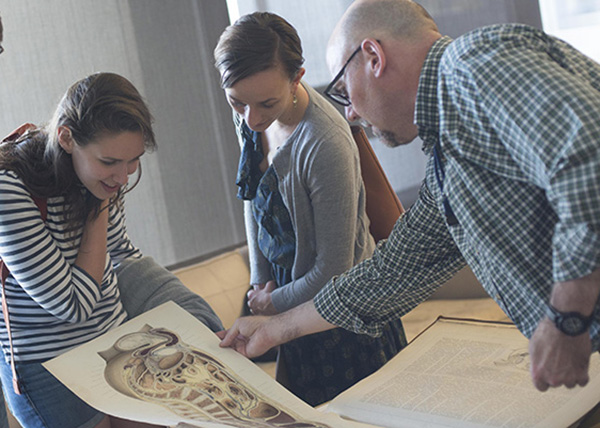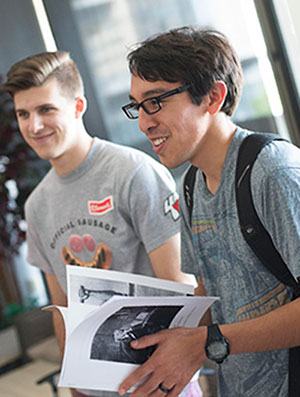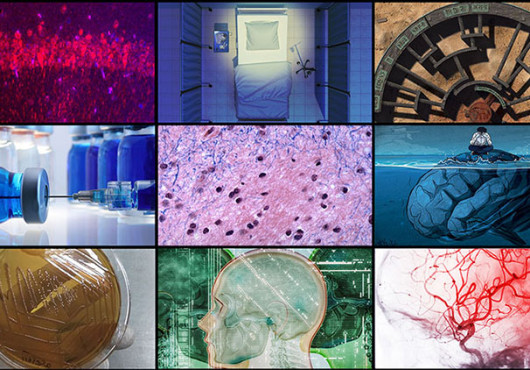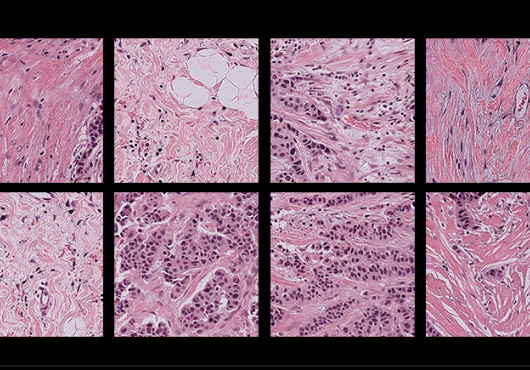
Looking over a plate from Wilhelm Braune's Topograpisch-anatomischer atlas from 1872. From left: first-year HMS students Emma Meyers and Whitney Fitts; Public Services Librarian, Jack Eckert.
With the conclusion of their Foundations anatomy class this month, first-year HMS medical students gathered in the Francis A. Countway Library of Medicine’s Lahey Room to receive a special reward—a first-hand look at some of the world’s rarest anatomical artifacts.
Unique and unusual items from the Center for the History of Medicine and the Warren Anatomical Museum collections at Countway Library were displayed during HMS’s first-ever Anatomy Day exhibit on Sept. 18, designed to provide students with a view into the anatomical past.
“It gives a sense of the history of it all,” reflected first-year medical student Luis Fandino. “We come here and get to see what it took to get to where we are now.”

Different stations highlighted the evolution of anatomy through the centuries. At a station featuring early and Renaissance manuscripts, students thumbed through Andreas Vesalius’ illustrations of the muscular and skeletal systems.
At the 18th and 19th century European anatomy station, students peeked at William Hunter’s atlas of uterine anatomy. There were also reminders of the ethically problematic history of body procurement in anatomy as exemplified in the Pernkopf atlas from the Nazi period.
The “History of Harvard” anatomy station included a mesmerizing, late 19th century corrosion cast of the bronchi and trachea of a small animal. Near it, students could examine a display of pristinely preserved, dissected and dried muscles of the cervical vertebrae, prepared by Oliver Wendell Holmes in 1862.
“There is a lot of history involved. Having just finished our anatomy course, it is interesting to see how the field of anatomy has evolved,” said Jenny Shih, one of 174 first-year medical students who completed the Foundations anatomy course.
Sabine Hildebrandt, an anatomy instructor, said she was inspired to bring the students to see the Countway collection by a similar Anatomy Day event held at Duke University’s Rubenstein Rare Book and Manuscript Library. She said she wanted to provide her HMS students with a richer historical context for the anatomy material she helped to present within the School’s new, more compressed first-year curriculum timeline.
“It was very easy,” said Hildebrandt, also an HMS assistant professor of pediatrics at Boston Children’s Hospital. “I ran into open doors here. The students were very happy to hear about the history and ethics of anatomy.”
Hildebrandt and co-director of the Foundations anatomy course, Trudy Van Houten, hope to make Anatomy Day an annual event at HMS, marking the end of the first part of the rigorous HMS anatomy curriculum.
“It gives a sense of the history of it all. We come here and get to see what it took to get to where we are now.”- Luis Fandino, first-year medical student
Hildebrandt said she attributed much of the success of the first Anatomy Day to the helpfulness of the staff at the Countway Library’s Center for the History of Medicine, which houses some of the world’s leading history collections in medicine, public health, health care and biosciences.
“One of the great advantages of having the Center for the History of Medicine on campus is that it allows future physicians to put themselves on the historical timeline,” said Dominic Hall, curator of the Warren Anatomical Museum, which provided many of the artifacts for Anatomy Day.
“Students are part of a continuum, and events like this can help students place themselves in relation to that timeline of medical discovery,” he said.
Visit the Center for the History of Medicine and the anatomical artifacts found in the Warren Anatomical Museum for more information. For more information on courses offered in the HMS anatomy curriculum contact Trudy Van Houten.


